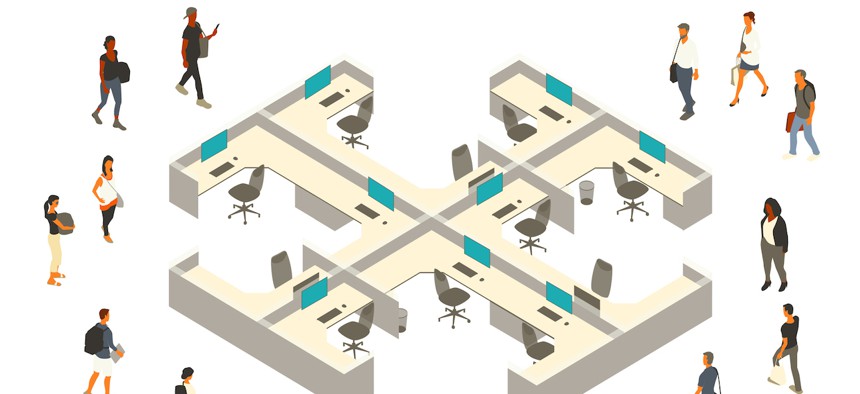Rushing the Return to Office: Why Forcing Feds into In-Person Work Could Backfire
Agency leaders need to make informed, data-driven decisions about the path forward.
The Office of Management and Budget issued guidance recently to ensure the policies governing agency work environments optimize organizational health and performance. Embedded in the 20-page document is a clear expectation that agencies “substantially increase meaningful in-person work at federal offices.” House Committee on Oversight and Accountability Chairman James Comer, R-Ky., suggested OMB’s guidance was not enough, saying, “It’s essential the federal workforce get back to the workplace and provide better service to the American people.”
Let’s not be hasty. For those of us working with federal agencies to create effective hybrid and remote work postures, it is clear both OMB and Rep. Comer’s stances invite significant risk with no clear reward. How do we know? As part of our support for a leading federal agency, we conduct quarterly workforce pulse surveys to assess employee perspectives on their work environment. In the most recent iteration of the survey, more than 40% of respondents stated they would seek alternative employment if current telework flexibilities were changed. That is a huge number – and one that should cause both the executive and legislative branches to take a collective pause.
It is fair to attribute at least some portion of that 40% to survey bluster, but we would argue the potential impact is even more compelling than first glance suggests, given the federal government’s ongoing challenge to fill open positions. If even an extra 10% of agency staff left, where would their replacements come from? According to the Bureau of Labor Statistics, there were 138,000 openings across federal departments and agencies in February 2023, but just 48,000 people were hired. It also takes too long to hire in the federal government – many positions take more than 100 days to fill. The system is simply not ready for a mass exodus of federal employees, and Congress and OMB’s concerns over quality of customer service would only be exacerbated by staff shortages.
So, what should policymakers and agency leadership do to ensure optimal work environments in this new climate of uncertainty and risk?
Empower executives to create agency-specific guidelines, and individual supervisors to make decisions on telework frequency. OMB’s recent guidance rightly stresses the importance of mission and service delivery. However, the requirements to achieve missions are unique to individual agencies. Each agency leadership team should be empowered to set work environment guidelines that maximize their ability to achieve the mission and promote employee flexibilities. Similarly, individual supervisors who are accountable for work group performance, should be allowed to set employee telework frequency, while executives carefully assess those decisions to ensure they are not self-serving, monitor organizational performance, and demand improvement when needed.
Create effective methods to ensure accountability. OMB’s guidance strikes the right tone on the importance of developing organizational health and performance frameworks that incorporate work environment planning. Metrics around mission delivery; employee engagement and satisfaction; diversity, equity, inclusion, and accessibility considerations; talent acquisition and workforce management; and retention are good starting points. In our experience, many agencies make this type of analysis too complex. Long-term evaluations and causal studies are important, but a scaled down assessment effort can be just as impactful. By merging a few existing HR data sets, a good analyst can cross-reference the above indicators by employee telework frequency and provide executives with useful insights on trends in productivity, satisfaction, and mission delivery.
Embrace agility and phased implementation. If the pandemic has taught federal leaders anything, it is to expect the unexpected. No agency will create a perfect work environment plan in the coming months, so governance and review mechanisms should be put in place to adjust the agency’s posture once additional insights are available.
Manage risk through pilot deployments and strengthened HR capabilities. For agencies to effectively optimize their work environments and reduce risk of employee attrition, they should start with pilot deployments to test hypotheses about employee responses to change and improvement in mission delivery. If the pilot pans out, decision makers can then leverage data collected to expand the initiative more broadly. At the same time, HR capabilities should be strengthened to offset any attrition, including leaning in on hiring flexibilities and hiring reform, adopting leading recruiting practices, and reengineering burdensome HR processes.
The pressure to improve the federal workplace environment stems from a noble goal – to improve mission and service delivery to the American public. No taxpayer could be against that. However, immediate, wholesale change and a hastened, mandatory return to the office are almost certain to make things worse. Expecting employees to come back to the office simply because downtowns are suffering is not fair. OMB and agency leadership should slow down; test hypotheses to collect evidence about what works; and make informed, data-driven decisions about the path forward.
Robert Shea is CEO of GovNavigators, LLC. Andrew Stegmeier is COO of Management Science & Innovation.
NEXT STORY: Biden's Archivist Nominee is Confirmed





